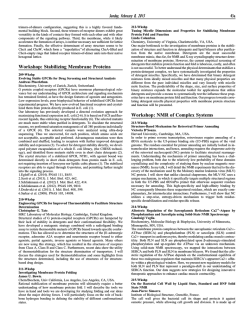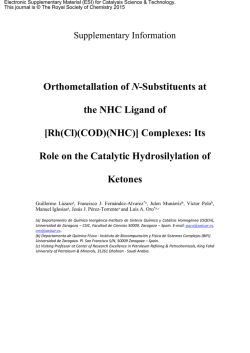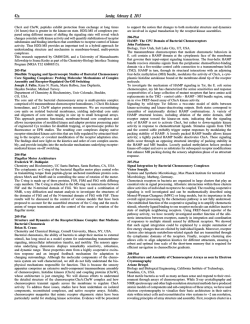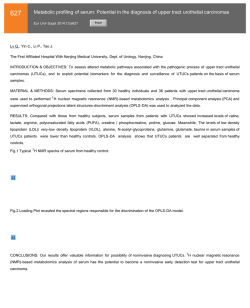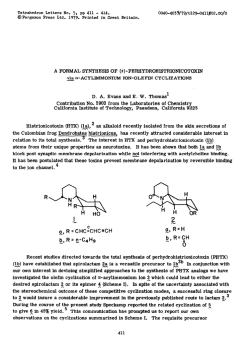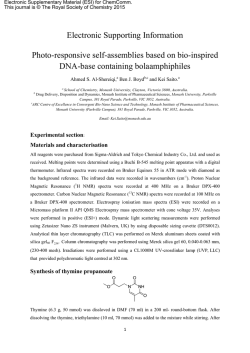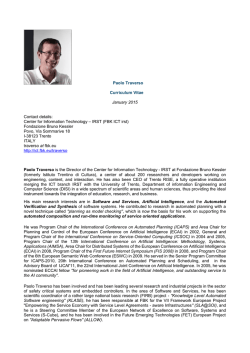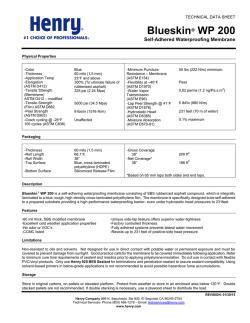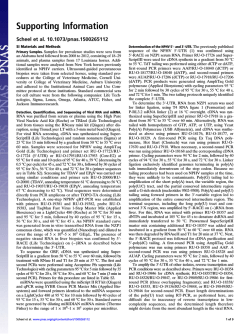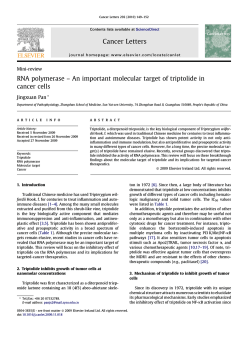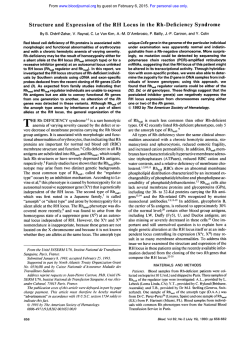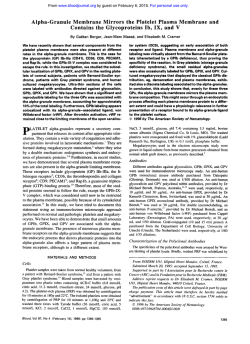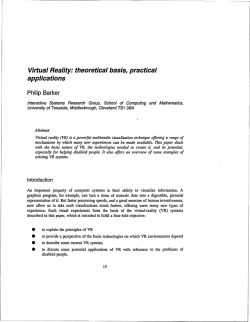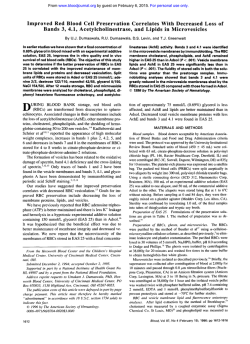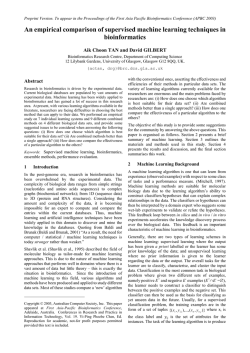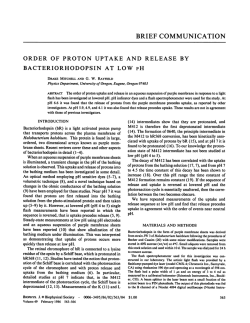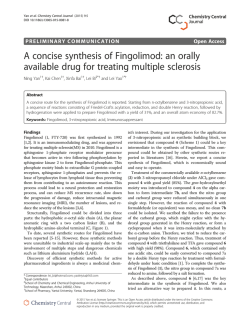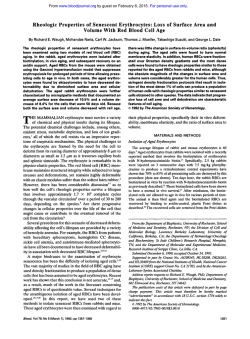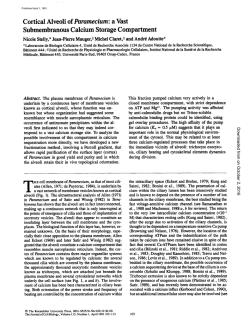
On the Bacterial Cell Wall by Liquid State, Standard and DNP Solid
Sunday, February 8, 2015 trimers-of-dimers configuration, suggesting this is a highly favored fundamental building block. Second, these trimers-of-receptor dimers exhibit great versatility in the kinds of contacts they formed with each other and with other components of the signaling pathway. Third, the membrane, while it likely accelerates the formation of arrays, is neither necessary nor sufficient for lattice formation. Finally, the effective determinant of array structure seems to be CheA and CheW, which form a ‘‘superlattice’’of alternating CheA-filled and CheA-empty rings that linked receptor trimers-of-dimer units into their native hexagonal lattice. Workshop: Stabilizing Membrane Proteins 209-Wkshp Evolving Stable GPCRs for Drug Screening and Structural Analysis Andreas Plueckthun. Biochemistry, University of Zurich, Zurich, Switzerland. G protein coupled receptors (GPCRs) have enormous pharmacological relevance but our understanding of GPCR architecture and signaling mechanism has remained limited, as have the design features of agonists and antagonists. Low expression levels, poor biophysical behavior of solubilized GPCRs limit experimental progress. We have now evolved functional receptors and crystallized them from protein directly produced in E. coli (1). Our laboratory has previously developed a directed evolution approach for maximizing functional expression in E. coli (2-6). It is based on FACS and fluorescent ligands, thus enforcing receptor functionality (6). The selected mutants are much more stable when purified in detergents. To elucidate the structural reasons, we performed saturation mutagenesis of all 380 positions individually of a GPCR (4). The selected variants were analyzed using ultra-deep sequencing. Thus we uncovered, for each position, which amino acids are not acceptable, acceptable and preferred. Advantageous mutations were then combined and shuffled, leading to receptors with further improved detergent stability and expression (3). To select for detergent stability directly, we developed polymer encapsulation of a whole E. coli library, (the CHESS technology), and identified those mutants stable even in short chain detergents (2). The crystal structure of a stabilized GPCR, NTR1, with agonist bound was determined directly in short chain detergents from protein made in E. coli, not requiring insertion of lysozyme nor lipidic cubic phases (1). The stabilized receptors are able to signal through G-proteins, and permitting further insight into the signaling process. 1.Egloff et al. (2014). PNAS 111, E655. 2.Scott et al. (2013). J. Mol. Biol. 425, 662. 3.Schlinkmann et al. (2012) J. Mol. Biol. 422, 414. 4.Schlinkmann et al. (2012). PNAS 109, 9810. 5.Dodevski et al. (2011). J. Mol. Biol. 408, 599. 6.Sarkar et al. (2008). PNAS 105, 14808. 210-Wkshp Engineering GPCRs for Improved Thermostability to Facilitate Structure Determination Christopher G. Tate. MRC Laboratory of Molecular Biology, Cambridge, United Kingdom. Structural studies of G protein-coupled receptors (GPCRs) are hampered by their lack of stability in detergents and their conformational flexibility. We have developed a mutagenic strategy combined with a radioligand binding assay to isolate thermostable mutants of GPCRs biased towards specific conformations. This has allowed us to determine the structures of the b1-adrenergic receptor, adenosine A2A receptor and neurotensin receptor bound to either agonists, partial agonists, inverse agonists or biased agonists. Many others are now using this strategy, which has resulted in the structures of receptors from Class A, Class B and Class C. Furthermore, recent data show the utility of thermostabilisation for the structure dtermination of transporters. I will discuss the strategies used for thermostabilisation and some highlights from the structures determined, including the use of structures of for structurebased drug design. 211-Wkshp Investigating Membrane Protein Folding James U. Bowie. Chem/Biochem, Univ California, Los Angeles, Los Angeles, CA, USA. Rational stabilization of membrane proteins will ultimately require a better understanding of how membrane proteins fold. I will describe the tools we have in hand and tools we are developing for studying folding and our ideas about the major driving forces. I will particularly focus on the role of backbone hydrogen bonding in defining the stability of different conformational states. 43a 212-Wkshp Tuning Micelle Dimensions and Properties for Stabilizing Membrane Protein Fold and Function Linda Columbus. Chemistry, University of Virginia, Charlottesivlle, VA, USA. One major bottleneck to the investigation of membrane proteins is the stabilization of structure and function in detergents and lipid bilayers after purification from the native membrane. Detergents are the most successful membrane mimic, thus far, for NMR and X-ray crystallography structure determination of membrane proteins. However, the current empirical screening of detergents that stabilize protein function and fold is laborious, costly, and often is not successful. To better understand the physical determinants that stabilize a protein-detergent complex, we have systematically investigated the properties of detergent micelles. Specifically, we have determined that binary detergent mixtures form ideally mixed micelles and that many physical properties are different from the pure individual micelles and vary linearly with micelle mole fraction. The predictability of the shape, size, and surface properties of binary mixtures expands the molecular toolkit for applications that utilize detergents and provide a means to systematically test the influence these properties have on membrane protein fold and function. Our progress towards correlating detergent micelle physical properties with membrane protein structure and function will be presented. Workshop: NMR of Complex Systems 213-Wkshp Structure-Based Mechanism for Retroviral Primer Annealing Victoria D’Souza. Harvard University, Cambridge, MA, USA. In order to prime reverse transcription, retroviruses require annealing of a tRNA molecule to the U5-primer binding site (U5-PBS) region of the viral genome. The residues essential for primer annealing are initially locked in intramolecular interactions, and hence, annealing requires the chaperone activity of the retroviral nucleocapsid (NC) protein to facilitate structural rearrangements. Understanding the mechanism of primer annealing has been a challenging problem, both due to the relatively low probability of these domains crystallizing and the complexity of studying them by nuclear magnetic resonance (NMR). In my talk, I will detail the NMR experiments that led to the discovery of the mechanism used by the Moloney murine leukemia virus (MLV) NC protein. I will show that unlike classical chaperones, the MLV-NC uses a unique mechanism, in which it specifically targets multiple structured regions in both the U5-PBS and tRNAPro primer that otherwise sequester residues necessary for annealing. This high-specificity and high-affinity binding by NC consequently liberates these sequestered residues_which are exactly complementary_for intermolecular interactions. Furthermore, I will show that NC utilizes a step-wise, entropy-driven mechanism to trigger both residuespecific destabilization and residue-specific release. 214-Wkshp Allosteric Regulation of the Sarcoplasmic Reticulum Ca2D-Atpase by Phospholamban and Sarcolipin using Solid-State NMR Spectroscopy Gianluigi Veglia. Biochemistry, Molecular Biology & Biophysics, University of Minnesota, Minneapolis, MN, USA. The membrane protein complexes between the sarcoplasmic reticulum Ca2þATPase (SERCA) and phospholamban (PLN) or sarcolipin (SLN) control Ca2þ transport in cardiomyocytes, thereby modulating cardiac muscle contractility. Both PLN and SLN are phosphorylated upon b-adrenergic-stimulated phosphorylation and up-regulate the ATPase via an unknown mechanism. Using solid-state NMR spectroscopy, we mapped the interactions between SERCA and both PLN and SLN in membrane bilayers. We found that the allosteric regulation of the ATPase depends on the conformational equilibria of these two endogenous regulators that maintain SERCA’s apparent Ca2þ affinity within a physiological window. Here, we present new regulatory models for both SLN and PLN that represent a paradigm-shift in our understanding of SERCA function. Our data suggests new strategies for designing innovative therapeutic approaches to enhance cardiac muscle contractility. 215-Wkshp On the Bacterial Cell Wall by Liquid State, Standard and DNP Solid State NMR Jean-Pierre Simorre. Institute of Biological Structure, Grenoble, France. The cell wall gives the bacterial cell its shape and protects it against osmotic pressure, while allowing cell growth and division. It is made up of 44a Sunday, February 8, 2015 peptidoglycan (PG), a biopolymer forming a multi-gigadalton bag-like structure, and additionally in Gram-positive bacteria, of covalently linked anionic polymers called wall teichoic acids (WTA). The machinery involved in the synthesis of this envelop is crucial and is one of the main antibiotic target. Different protein as transpeptidase, activator or hydrolase are recruited to maintain it morphogenesis during the bacterial cell cycle. Based on few examples involved in the machinery of synthesis of the peptidoglycan, we will demonstrates that a combination of liquid and solidstate NMR can be a powerful tool to screen for cell-wall interacting proteins in vitro and on cell.(1-2) In particular, structure of the L,D-transpeptidases that results in b-lactam resistance in M. tuberculosis, has been studied in presence of the bacterial cell wall and in presence of antibiotic. In parallel, we have investigated the potential of Dynamic Nuclear Polarization (DNP) to study cell surface directly in intact cells.(3) Our results show that increase in sensitivity can be obtained together with the possibility of enhancing specifically cell-wall signals. References: 1) Egan et al. (2014). Outer-membrane lipoprotein LpoB spans the periplasm to stimulate the peptidoglycan synthase PBP1B. PNAS 111, 8197-8202. 2) Lecoq et al. (2013). Structure of Enterococcus faecium l,d-transpeptidase acylated by ertapenem provides insight into the inactivation mechanism. ACS Chem Biol 8, 1140-1146. 3) Takahashi et al. (2013) Solid-State NMR on Bacterial Cells: Selective Cell Wall Signal Enhancement and Resolution Improvement using Dynamic Nuclear Polarization. J Am Chem Soc. 216-Wkshp Solid-State NMR Study of Intact Microalgae Isabelle Marcotte. Chemistry, Universite du Quebec a Montreal, Montre´al, QC, Canada. The study of intact cells by solid-state NMR is challenging considering their high level of complexity. Therefore interactions with the lipid membranes for example have been traditionally studied using model cell membranes composed of a few representative lipids. Microalgae are excellent examples of the complexity of microorganisms. Their lipid-rich plasma membrane is, in most species, protected by a cell wall, and the cytoplasm contains a variety of organelles including the chloroplast and the nucleus, as well as storage lipids and sugars. Microalgal cell walls are diverse and can be made of cellulose, proteins, polysaccharides, silica or calcium carbonate. The diversity of lipids is also notable in terms of the headgroup variety encountered as well as degrees of unsaturation. Because microalgae are at the basis of the aquatic food chain, we are developing approaches to study the interaction of contaminants with these cells by solid-state NMR using magic-angle spinning (MAS) for maximum resolution. We have first established a protocol of 13C enrichment, enabling the acquisition of signal from all the constituents. Freshwater C. reinhardtii and marine water species P. lutheri and N. galbana have thus been 13C-labeled. The use of dynamic filters to evidence particular constituents will be discussed, such as experiments based on through-space (cross polarization) or throughbond (RINEPT) magnetization transfer to study rigid and dynamic components, respectively. Isotopic labeling strategies will also be discussed as well as the challenges to study interactions with the lipid membranes and cell wall. Workshop: Artificial Cells: Understanding and Engineering 217-Wkshp The Engineering of Artificial Cellular Systems using Synthetic Biology Approaches Cheemeng Tan. Biomedical Engineering, University of California, Davis, Davis, CA, USA. Artificial cellular systems are minimal systems that mimic certain properties of natural cells, including signaling pathways, membranes, and metabolic pathways. These artificial cells (or protocells) can be constructed following synthetic biology approaches by assembling biomembranes (the shell), synthetic gene circuits (the information), and cell-free expression systems (the engine). Specifically, we created new synthetic molecular systems to control genetic circuits of artificial cells. We also implemented a synthetic bacterial consortium for the synthesis of cell-free systems. Furthermore, we designed and tested a novel microfluidic platform for making uniform artificial cells. Since artificial cells are built from bottom-up using minimal and a defined number of components, they are more amenable to predictive mathematical modeling and engi- neered controls when compared to natural cells. Along this line, we will discuss the applications of artificial cells as drug delivery and in situ protein expression systems. Furthermore, we will discuss potential applications of artificial cells as biomimetic systems to unveil new insights into functions of natural cells, which are otherwise difficult to investigate due to their inherent complexity. It is our vision that the development of artificial cells will bring forth parallel advancements in synthetic biology, cell-free systems, and in vitro systems biology. 218-Wkshp Engineering Synthetic Ribosomes In Vitro Michael Jewett. Chemical and Biological Engineering, Northwestern University, Evanston, IL, USA. Purely in vitro ribosome synthesis could provide a critical step towards unraveling the systems biology of ribosome biogenesis, constructing minimal cells from defined components, and engineering ribosomes with new functions. To that end, we have developed an integrated synthesis, assembly, and translation technology (termed iSAT) for the in vitro construction of Escherichia coli ribosomes in crude ribosome-free S150 extracts. iSAT allows for the simultaneous in vitro synthesis of ribosomal RNA (rRNA), assembly of rRNA with purified ribosomal proteins, and transcription and translation of a reporter protein as a measure of ribosome activity. Here, we describe the development of, and recent improvements to, the iSAT system. Key breakthroughs include refining extract preparation, tuning the transcriptional balance of rRNA and mRNA production, and adding crowding and reducing agents. In addition to technological advances, we show that iSAT makes possible the in vitro construction of modified ribosomes by introducing a 23S rRNA mutation that mediates resistance against clindamycin. We also show that iSAT can be used for studying ribosome assembly. We anticipate that iSAT will aid studies of ribosome biogenesis and the construction of artificial cells. 219-Wkshp Measuring Gene Expression in Fly Embryos: From Single Molecules to Network Dynamics Thomas Gregor. Princeton University, Princeton, NJ, USA. The nodes of many genetic networks that are active during early development are transcription factors, i.e. proteins that cross-regulate each other via activating or repressive interactions. Hence, in order to understand generic properties of such transcription networks, obtaining quantitative access to the molecular players is key. In particular, in addition to proteins, quantitative handles to other molecular species such as RNA-polymerases and mRNA molecules are crucial to understand the transition from one network node to the next. I will report on our recent progress in developing methods to count individual molecules of mRNA in intact fly embryos, and to monitor in vivo the transcriptional activity of nascent mRNA at their site of production on the DNA. Initial applications and results using these methods will also be discussed. 220-Wkshp Evolution Experiment With Translation-Coupled RNA Replication System Tetsuya Yomo1,2. 1 Osaka University, Osaka, Japan, 2ERATO, JST, Osaka, Japan. The ability to evolve is a key characteristic that distinguishes living things from non-living chemical compounds. The construction of an evolvable cell-like system from non-living molecules has been a major challenge. We encapsulated an artificial RNA genome and the factors for protein synthesis into water droplets in oil or lipid vesicles to develop an evolvable artificial cell model. In the micro-compartments, the artificial genomic RNA replicates through the translation of its encoding RNA replicase gene. Using the translationcoupled RNA replication system, we performed a long-term (600-generation) evolution experiment, in which mutations were spontaneously introduced by the translated replicase into its genetic information. At the beginning, the amplified RNA genomes were in the double stranded form, a dead-end product for the translation while a small parasitic RNA appeared by a deletion mutation on the RNA genome and dominated the population by stealing the replicase translated from the RNA genome. But highly replicable mutant RNA genomes gradually evolved to eliminate the two short circuits by reinforcing the interaction with the translated replicase. At the end, two-order acceleration in replication rate was observed whereas the population declined when the same reaction was conducted in a bulk solution. The results indicated that the microcompartmentalization was essential for the assembly of the bio-polymers to evolve.
© Copyright 2025
